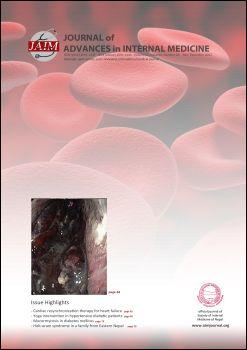Accuracy of commonly used equations for estimating glomerular filtration rate in Nepalese population
DOI:
https://doi.org/10.3126/jaim.v1i2.6503Keywords:
cockcroft gault, modification of diet in renal disease, glomerular filtration RateAbstract
Introduction - Estimation of glomerular filtration is of utmost importance in clinical practice. Various equations have been developed in different populations based on serum creatinine. These equations have not yet been validated in the Nepalese population. This study was conducted to compare the accuracy Cockcroft Gault and Modification of Diet in Renal Disease equations for estimating the glomerular filtration rate in Nepalese population.
Methods - A total of 100 patients with chronic kidney disease were included in the study. Fifty patients had serum creatinine less than 1.5 mg/dl and 50 patients had serum creatinine more than or equal to 1.5 mg/dl. Glomerular Filtration Rate was measured as creatinine clearance from 24 hour timed urinary collections and estimated using both the Cockcroft-Gault and Modification of Diet in Renal Disease equations for all the patients. The degree of accuracy of each equation was calculated by the coefficient of determination(R2).
Results - The mean glomerular filtration rate estimated from the Cockcroft Gault equation was 51.29 ml/min/1.73sqm and mean glomerular filtration rate estimated from the Modification of Diet in Renal Disease equation was 48.41 ml/min/1.73sqm whereas the mean measured GFR was 53.30ml/ min/1.73sqm. The coefficient of determination (R2) was calculated for both the equations. The Cockcroft Gault equation was more accurate in the Nepalese population (R2=0.88) than the Modification of Diet in Renal Disease equation whose coefficient of determination was 0.84.
Conclusions - In the Nepalese population the Cockcroft Gault equation was more accurate in estimating the glomerular filtration rate in comparison to the Modification of Diet in Renal Disease equation .
DOI: http://dx.doi.org/10.3126/jaim.v1i2.6503
Journal of Advances in Internal Medicine 2012;01(02):52-3
Downloads
Downloads
Published
How to Cite
Issue
Section
License
This license enables reusers to distribute, remix, adapt, and build upon the material in any medium or format, so long as attribution is given to the creator.




